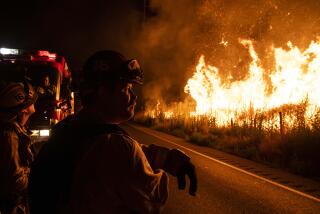Dozens of large blazes roaring across Northwest and West

University of Alaska-Fairbanks firefighting students Preston Roberts and Ben Schrage send up a cloud of steam as they douse a hot spot left from a wildfire in Chelan, Wash.
A Washington wildfire grew to be the largest in state history Monday as tens of thousands of firefighters battled to get the upper hand against dozens of large blazes across the West and Northwest.
The Okanogan Complex fire in northern Washington had grown to 256,657 acres as of Monday, according to firefighting officials — an area almost five times the size of Seattle.
It surged past last summer’s Carlton Complex fire, which claimed 256,108 acres, or just over 400 square miles.
More than 1,200 firefighters and support personnel were battling the Okanogan Complex fire, according to Carol Connolly, a spokeswoman for the Northwest Interagency Coordination Center.
But the Okanogan Complex fire — which, at 10% containment, still threatened more than 5,000 homes — was far from the only problem facing officials and homeowners in the Northwest.
Of the 1.5 million acres burned by active wildfires as of Monday, almost 1.1 million of those acres were in Washington and Oregon, according to the National Interagency Fire Center — 636,810 acres in Washington and 415,578 acres in Oregon. Dozens of homes have been destroyed in both states.
Active fires also have scorched 283,438 acres in California, 145,033 acres in Idaho and 48,732 acres in Montana.
“It’s a little bit crazy around here,” said Randy Eardley, a spokesman for the Boise, Idaho-based National Interagency Fire Center. “There is a tremendous amount of fire not only in Washington but across Idaho and into northern Montana.”
About 30,000 firefighters and support personnel have deployed to fight all the wildfires, Eardley said, including contingents from Australia, New Zealand and Canada.
Almost 10,000 personnel were deployed in Washington and Oregon alone, Connolly said — up from 7,000 a week ago, when firefighters were so overwhelmed that no backup was available. Two hundred Army service members from Joint Base Lewis-McChord also have joined the effort.
Washington officials made an unusual call for help last week, asking for volunteers. So far, 4,000 people have stepped forward.
Officials were hoping for volunteers with firefighting experience or heavy equipment that could be used for the fight, and 500 of the volunteers have been identified as promising candidates, said Joe Smillie, a spokesman for the Washington Department of Natural Resources.
Several hundred volunteers who didn’t make the cut have been referred to other relief agencies to pitch in once the fires calm down and recovery begins, Smillie said.
Wildfires across the U.S. have burned a total of 7.4 million acres so far this year, the largest total for the same period over the last decade, but more than 5 million of those acres have been in rural Alaska.
Hot temperatures and strong winds Monday led to red-flag warnings that fires could spread in Washington, Oregon, Northern California and Montana. Officials expect cooler temperatures and some moisture to arrive in the Pacific Northwest this weekend.
Until then, it’s not just the flames that firefighters and residents need to worry about.
Almost the entire state of Idaho was under an air quality alert as ash and particles from fires blew downwind, creating health hazards for those outdoors.
Large swaths of eastern Washington, eastern Oregon and western Montana were under similar warnings.
In Spokane, Wash., swimming pools closed and high school sports teams canceled outdoor practices because of air quality warnings, the Spokesman-Review reported.
Air sensors in some portions of central Idaho around the Nez Perce tribal reservation showed the air quality index reaching “hazardous” levels — the highest possible designation — with values higher than 300 on the scale, the worst in the state.
That’s the level at which officials urge residents not to do any physical activity outdoors.
“Good” air quality has an index value of zero to 50. Los Angeles and Beijing were both around 75 as of Monday morning.
With fires raging both on the reservation and off it — as well as upwind in Washington and Oregon — Julie Simpson, the coordinator for the Nez Perce Tribe Air Quality Program, said the levels were the worst her program had seen since testing began in 2001.
“Folks are definitely experiencing allergic response symptoms, sinus infections, and folks with asthma are having an especially hard time and needing to use their inhalers,” Simpson said.
Wildfires in the region made 2012 and 2014 particularly bad years for air quality, she said, “but this year far surpasses anything we’ve seen to date.”
As a result, the tribe has issued air quality advisories for three weeks straight, with the possibility of “hazardous” conditions extending through this week, Simpson said.
Follow @MattDPearce for national news
ALSO:
Chaotic day on Wall Street ends with Dow down 588 points
James Holmes prosecutor talks about the holdout juror who spared the killer’s life
North and South Korea reach deal to end ‘semi-state of war’
More to Read
Sign up for Essential California
The most important California stories and recommendations in your inbox every morning.
You may occasionally receive promotional content from the Los Angeles Times.










